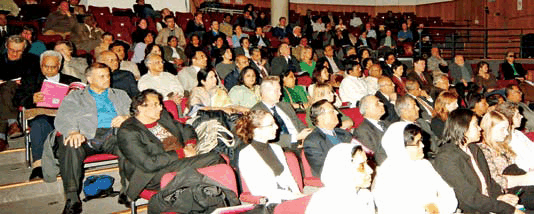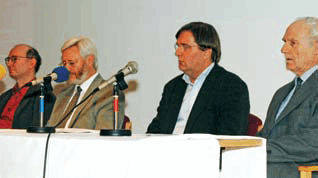 The 8th international Jaina Studies Workshop at SOAS was funded by the British Arts and Humanities Research Council as part of the research project on Jaina Law and Identity at SOAS. The conference was opened with the launch of Studies in Jaina History and Culture: Disputes and Dialogues, a voluminous collection of selected papers of previous Jaina Studies Workshops at SOAS between 1999 and 2003. It was the first volume of the new series: Advances in Jaina Studies (Routledge), which together with the International Journal of Jaina Studies, serves as the principal publication medium for future conference proceedings. The second volume of the series, a monograph by Paul Dundas, has appeared in autumn 2006.
The 8th international Jaina Studies Workshop at SOAS was funded by the British Arts and Humanities Research Council as part of the research project on Jaina Law and Identity at SOAS. The conference was opened with the launch of Studies in Jaina History and Culture: Disputes and Dialogues, a voluminous collection of selected papers of previous Jaina Studies Workshops at SOAS between 1999 and 2003. It was the first volume of the new series: Advances in Jaina Studies (Routledge), which together with the International Journal of Jaina Studies, serves as the principal publication medium for future conference proceedings. The second volume of the series, a monograph by Paul Dundas, has appeared in autumn 2006.
The conference addressed the question of how Jain culture reproduces itself socially, sandwiched as it is today between a thin layer of Jain mendicants and lay virtuosi and society as a whole. What are the main features of Jain culture, society, and law? And how are social identities constructed and perpetuated? The thought provoking keynote lecture by Johannes Bronkhorst of the University of Lausanne, 'Jainism, window on early India', argued that Jainism, far from being an offshoot of Vedic religion, originated in the latter part of the first millennium BCE in the altogether different surroundings of 'Greater Magadha', where an independent sramana culture of Nigganthas (Jains), Ajlvikas, Buddhists and others prevailed which may have been infiltrated by individual Brahmins but not yet dominated by Brahmin culture. The second day of the conference began with an art historical paper by Robert J. Del Bonta from San Francisco ('From Herodotus onwards: descriptions of unidentified Jainas') on images of Jains in 16th and 17th century European literature, especially in Bernard Picart's (1673-1733) monumental work Ceremonies et coutumes religieuses. The presented evidence suggested 'that although not seen as a  fully separate religion, the Jainas were considered [by Europeans] a special group from the earliest times'. Dharma Chandra Jain of the University of Jodhpur then spoke on 'The concept of soc ety in Jainism' in canonical and medieval Jain literature. Using examples, he highlighted the individual centred, atomistic view of society in Jain depictions of social intercourse, and the predominance of ethical considerations. The following paper by Satya Ranjan Banerjee of the University of Calcutta, 'Jain society in the reign of Jain kings', gave a comprehensive overview of the social conditions of the Jains of India in the reigns of the South Asian kings from the times of Mahavira onwards on the basis of inscriptions and textual evidence. Sushil Jain of Assumption University in Canada addressed the 'Jaina contribution to the science of polity with respect to Somadeva's Nltivakyamrtam', a famous 10th century Digambara Jain Sanskrit text on kingship, or raja dharma. The wide-ranging paper argued that the text has been somewhat misunderstood by scholars who focused exclusively on its depiction of legitimate war. The next lecture by Hampa Nagarajaiah from the University of Bangalore used case material from literature and inscriptions in medieval Karnataka to illustrate the importance of the institution of sastradana, the donation of scripture, for the reproduction of Jain culture, which cannot rely on rituals and social customs alone. He focused on the donations of the 10th century 'great woman' (mahasatl) Attimabbe, and showed rare photographs of the once single surviving manuscript of Puspadanta and Bhutabali's 2nd - 3rd century CE Prakrit text Satkhandagama, one of the most important Digambara treatises which is kept in the monastery (matha) of the bhattaraka of Mudabidri in coastal Karnataka. The 12th century palm leaf manuscript was virtually inaccessible and its contents unknown until a copy was smuggled out in 1896-1916, and later published by with a Hindi translation by Hiralal Jain between 1939 and 1958. Kornelius Krmpelmann of the University of Mnster concluded the morning session with an impressive lecture on 'The Sthanangasutra: An encyclopaedic text of the Svetambara canon'. He described the contents and the literary style of the work, its time of origin and its authorship, and showed convincingly through a linguistic analysis that the earliest commentary on the Sthanangasutra, composed by Abhayadevasuri in 1063 CE, misinterpreted the structure of the text in terms of the then fashionable naya theories rather than recognising it as an incoherent and simply numbered list of items for educational purposes.
fully separate religion, the Jainas were considered [by Europeans] a special group from the earliest times'. Dharma Chandra Jain of the University of Jodhpur then spoke on 'The concept of soc ety in Jainism' in canonical and medieval Jain literature. Using examples, he highlighted the individual centred, atomistic view of society in Jain depictions of social intercourse, and the predominance of ethical considerations. The following paper by Satya Ranjan Banerjee of the University of Calcutta, 'Jain society in the reign of Jain kings', gave a comprehensive overview of the social conditions of the Jains of India in the reigns of the South Asian kings from the times of Mahavira onwards on the basis of inscriptions and textual evidence. Sushil Jain of Assumption University in Canada addressed the 'Jaina contribution to the science of polity with respect to Somadeva's Nltivakyamrtam', a famous 10th century Digambara Jain Sanskrit text on kingship, or raja dharma. The wide-ranging paper argued that the text has been somewhat misunderstood by scholars who focused exclusively on its depiction of legitimate war. The next lecture by Hampa Nagarajaiah from the University of Bangalore used case material from literature and inscriptions in medieval Karnataka to illustrate the importance of the institution of sastradana, the donation of scripture, for the reproduction of Jain culture, which cannot rely on rituals and social customs alone. He focused on the donations of the 10th century 'great woman' (mahasatl) Attimabbe, and showed rare photographs of the once single surviving manuscript of Puspadanta and Bhutabali's 2nd - 3rd century CE Prakrit text Satkhandagama, one of the most important Digambara treatises which is kept in the monastery (matha) of the bhattaraka of Mudabidri in coastal Karnataka. The 12th century palm leaf manuscript was virtually inaccessible and its contents unknown until a copy was smuggled out in 1896-1916, and later published by with a Hindi translation by Hiralal Jain between 1939 and 1958. Kornelius Krmpelmann of the University of Mnster concluded the morning session with an impressive lecture on 'The Sthanangasutra: An encyclopaedic text of the Svetambara canon'. He described the contents and the literary style of the work, its time of origin and its authorship, and showed convincingly through a linguistic analysis that the earliest commentary on the Sthanangasutra, composed by Abhayadevasuri in 1063 CE, misinterpreted the structure of the text in terms of the then fashionable naya theories rather than recognising it as an incoherent and simply numbered list of items for educational purposes.
 The first part of the conference was mainly historical and textually oriented, while the second part was concerned with contemporary Jainism and Jains. The paper of Werner Menski (SOAS) on 'Jaina law as a natural law system' introduced a new theoretical model which combines three different kinds of rules - state, social, ethical/moral/religious - to generate subtle analytical types for the description of natural legal systems such as Jaina law from the point of view of legal pluralism. It argued that the 'identity postulate' inherent in Jaina law makes it recognisable as a natural law system. Peter Flgel's (SOAS) contribution ('Jaina law and the Jain community') presented an extended case study of the controversial recent judgement of the Supreme Court of India which rejected Jain 'minority' status on the grounds that many Jains prefer to be categorised as part of the 'Hindu' majority. It showed, on the basis of an analysis of historical Jain newspapers, that self-categorisations vary contextually and according to social and sectarian background; and how 'Jainism' and 'Jaina law' were intentionally constructed by liberal Jain communalists to maximise the political and social influence of the Jains in the colonial period, though the structure of Jain society can be better understood as a network of small and often ephemeral groups observing a variety of customs rather than as a single corporate ('ethnic') group or 'community', irrespective of official legal definitions. Ravindra K. Jain of the Jawaharlal Nehru University in New Delhi analysed a recent case of Jain factionalism in his lecture 'Religious response to social unrest: the rise of the Kanji Svami sect in contemporary Jainism'. He argued that the split that was caused by Kanji Svami within the contemporary Digambaras can be understood in terms of anthropological theories of the rise of millenarian movements in periods of social unrest. The paper of Ulrich Oberdiek, from Freiburg, on 'Caste identity of the Agravals in an Uttaranchal market town' analysed the mixed Jain-Hindu religious structure of
The first part of the conference was mainly historical and textually oriented, while the second part was concerned with contemporary Jainism and Jains. The paper of Werner Menski (SOAS) on 'Jaina law as a natural law system' introduced a new theoretical model which combines three different kinds of rules - state, social, ethical/moral/religious - to generate subtle analytical types for the description of natural legal systems such as Jaina law from the point of view of legal pluralism. It argued that the 'identity postulate' inherent in Jaina law makes it recognisable as a natural law system. Peter Flgel's (SOAS) contribution ('Jaina law and the Jain community') presented an extended case study of the controversial recent judgement of the Supreme Court of India which rejected Jain 'minority' status on the grounds that many Jains prefer to be categorised as part of the 'Hindu' majority. It showed, on the basis of an analysis of historical Jain newspapers, that self-categorisations vary contextually and according to social and sectarian background; and how 'Jainism' and 'Jaina law' were intentionally constructed by liberal Jain communalists to maximise the political and social influence of the Jains in the colonial period, though the structure of Jain society can be better understood as a network of small and often ephemeral groups observing a variety of customs rather than as a single corporate ('ethnic') group or 'community', irrespective of official legal definitions. Ravindra K. Jain of the Jawaharlal Nehru University in New Delhi analysed a recent case of Jain factionalism in his lecture 'Religious response to social unrest: the rise of the Kanji Svami sect in contemporary Jainism'. He argued that the split that was caused by Kanji Svami within the contemporary Digambaras can be understood in terms of anthropological theories of the rise of millenarian movements in periods of social unrest. The paper of Ulrich Oberdiek, from Freiburg, on 'Caste identity of the Agravals in an Uttaranchal market town' analysed the mixed Jain-Hindu religious structure of  the Agravala caste, and suggested on the basis of field observations, that life-style preferences based on family tradition and personal inclination are more important for identity choices than caste. Jitendra B. Shah of the L.D. Institute of Indology in Ahmedabad then presented a detailed historical overview of 'Jain societies in Ahmedabad', a city which is often called 'the capital of the Jainas', and highlighted historical contexts of specific institutional developments. The penultimate paper of the conference on 'Bodies of renunciation and ethical bodies: situating ethical discourses among Jains' by Anne Vallely of the University of Ottawa analysed the construction of Jain social identity in the contemporary Jain diaspora from the point of view of the individual and focused on the body as the principal site of Jain ethical discourse and on the symbolical importance of vegetarianism: 'You are what you eat'. The conference closed with the lecture of Julia A. B. Hegewald of the University of Heidelberg on 'Domes, tombs and minarets: Islamic influences on Jaina architecture' which demonstrated with the help of slides that there are a large number of Jaina religious structures throughout India which closely resemble Muslim mosque and tomb architecture; an issue which provoked an interesting discussion at the end of an enjoyable and informative conference, when Jain food (SOAS style) was appreciated by some two hundred scholars, students and Jains from all over the world.
the Agravala caste, and suggested on the basis of field observations, that life-style preferences based on family tradition and personal inclination are more important for identity choices than caste. Jitendra B. Shah of the L.D. Institute of Indology in Ahmedabad then presented a detailed historical overview of 'Jain societies in Ahmedabad', a city which is often called 'the capital of the Jainas', and highlighted historical contexts of specific institutional developments. The penultimate paper of the conference on 'Bodies of renunciation and ethical bodies: situating ethical discourses among Jains' by Anne Vallely of the University of Ottawa analysed the construction of Jain social identity in the contemporary Jain diaspora from the point of view of the individual and focused on the body as the principal site of Jain ethical discourse and on the symbolical importance of vegetarianism: 'You are what you eat'. The conference closed with the lecture of Julia A. B. Hegewald of the University of Heidelberg on 'Domes, tombs and minarets: Islamic influences on Jaina architecture' which demonstrated with the help of slides that there are a large number of Jaina religious structures throughout India which closely resemble Muslim mosque and tomb architecture; an issue which provoked an interesting discussion at the end of an enjoyable and informative conference, when Jain food (SOAS style) was appreciated by some two hundred scholars, students and Jains from all over the world.

 Dr. Peter Flügel
Dr. Peter Flügel